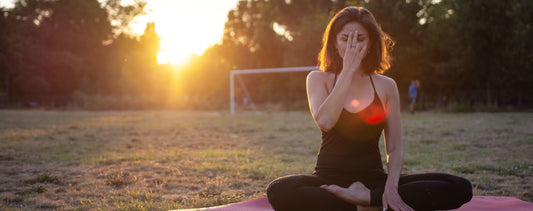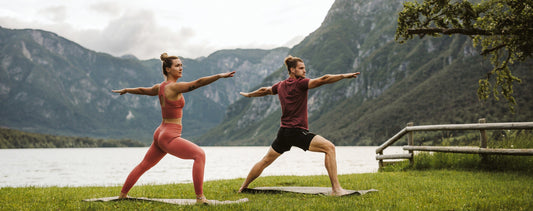As chilly winter nights cool the body, you may be looking for a way to warm up that doesn’t include turning up the heat. Heaters and layers can be drying and cumbersome. Thankfully, ancient pranayama techniques can help create and maintain warmth from within. Pranayama, one of the eight limbs of yoga, is a collection of breath exercises. Prana is that life force energy within each of you and Yama is restraint—together Pranayama translates to life force control or control of the breath.
Breathing is something you do all day long and you don’t usually have to think about. But paying attention to your breath cycles can be a powerful practice in focus and can immensely relieve stress and calm the nervous system. The following practices can be combined with meditation and yoga asana or on their own to build some heat.
Note of caution: Some of these practices may lead to slight lightheadedness, so always make sure you’re in a comfortable, safe place, preferably seated on a couch or cushion.
How to:
How to:
How to:
How to:
How to:
May these practices bring you a sense of calm and well-being as well as revitalized energy. Enjoy the many benefits of paying attention to your breath, including feeling toastier!
*Editor’s Note: The information in this article is intended for your educational use only; does not necessarily reflect the opinions of the Chopra Center's Mind-Body Medical Group; and is not a substitute for professional medical advice, diagnosis, or treatment. Always seek the advice of your physician or other qualified health providers with any questions you may have regarding a medical condition and before undertaking any diet, supplement, fitness, or other health program.
Find support for restful sleep with Pranayama for Sleep, a four-part series with Dr. Amit Anand, available now in the Chopra App.
Breathing is something you do all day long and you don’t usually have to think about. But paying attention to your breath cycles can be a powerful practice in focus and can immensely relieve stress and calm the nervous system. The following practices can be combined with meditation and yoga asana or on their own to build some heat.
Note of caution: Some of these practices may lead to slight lightheadedness, so always make sure you’re in a comfortable, safe place, preferably seated on a couch or cushion.
Box Breathing
This breath practice involves breathing in, breathing out, and retaining the breath—all for the same amounts of time. It can be helpful to visualize a square or box shape to remember to breathe in equal increments. This is a calming breath and is sometimes used in therapeutic settings.How to:
- Find a comfortable seat.
- Rest your palms on your thighs or somewhere on your torso.
- Take a few deep breaths to get centered and prepared.
- Inhale for a count of four. (Count silently.)
- Hold your breath in for a count of four.
- Exhale for a count of four.
- Hold your breath out for a count of four.
- Repeat as many times as you like.
Ujjayi Breath
This is the breath practice commonly used in hatha and vinyasa yoga. It is intended to warm the body from the inside out and keep the mind focused on the present moment. This style of breathing is a helpful tool because you can both hear it and feel it. This is a simultaneously energizing and grounding breath. Ujjayi means victorious; each inhale and exhale is a celebration of life. It is also sometimes called the “oceanic breath” because, if you listen closely, each cycle sounds like the waves coming in and out at the shore.How to:
- Find a comfortable position—sitting, standing, or reclining.
- Rest your hands by your sides or somewhere on your torso.
- Take a few deep breaths to get centered and prepared.
- Seal your lips lightly and separate your teeth.
- Rest your tongue lightly behind your front teeth.
- As you inhale through your nose, create a slight constriction at the back of your throat to generate a soft wheezing sound.
- As you exhale through your nose, keep the constriction at the back of your throat to maintain the wheezing sound as you push the air out.
- At the end of your exhale, draw your navel into your abdomen to push out any remnants of air.
- Engage your abdomen gently as you continue for as long as you’d like.
Wim Hof Breath
This is the breath technique pioneered by Dutch extreme athlete Wim Hof intended to optimize health and athletic performance. Paying attention to the breath is the intention here so it doesn’t matter if your breath is drawn in and out through your nose or mouth, or what your exact body position is.How to:
- Find a comfortable seat.
- Rest your palms on your thighs.
- Breathe in fully, breathe out fully. (Breath may be in and out through the nose or the mouth.)
- Try to make a full circle from inhaling to exhaling and back to the next inhale.
- Repeat 30 to 40 breath cycles.
- After the final round, hold your breath for as long as you can.
- Option: perform as many push-ups as possible while retaining your breath.
Kapalabhati Breath
This is a go-to practice for warming up quickly. Often called the “skull-shining breath,” this is a beneficial breath for when you want to feel warm, energized, and light. Kapalabhati breath may be a good technique if you’re feeling a general wintertime sluggishness or need warming up first thing in the morning.How to:
- Find a comfortable seat.
- Rest your palms on your thighs.
- Take a few deep breaths to get centered and prepared.
- Inhale fully through your nose and exhale fully through your mouth.
- Then inhale three quarters of the way through your nose and begin a quick, sharp exhale.
- Your inhale breaths will happen naturally.
- With each exhale forcefully push the air out of your lungs using the strength of your diaphragm and abdominal muscles.
- Continue for 10 to 20 cycles. Inhale fully through your nose and exhale fully through your mouth. Observe how you feel.
- Repeat the cycle a few times.
Twisting with Breath
This breath is practiced standing and will stimulate circulation of blood flow to the limbs. This helps with cold hands and feet in particular! Twisting breath may be a good technique to perform before hitting the slopes, heading out for an early morning run, or going for a winter surf session.How to:
- Stand with your feet wider than hip-width apart.
- Take a few deep breaths to get centered and prepared.
- Extend your arms out to your sides to ensure that you won’t hit anything or anyone as you move.
- Begin to twist and allow your arms to fly.
- Increase the speed and vigor of your movements as you feel warmer.
- For an added benefit, let your hands begin to slap your shoulders, low back, and chest as your arms fly.
- Let your breath occur naturally.
- Alternatively, inhale at center and exhale as you twist.
- Your feet can stay planted or your heels may lift as you twist from one side to the other.
- Continue for one to two minutes.
- Then stop twisting, rest your hands down by your sides, and notice your heart beating a little faster.
May these practices bring you a sense of calm and well-being as well as revitalized energy. Enjoy the many benefits of paying attention to your breath, including feeling toastier!
*Editor’s Note: The information in this article is intended for your educational use only; does not necessarily reflect the opinions of the Chopra Center's Mind-Body Medical Group; and is not a substitute for professional medical advice, diagnosis, or treatment. Always seek the advice of your physician or other qualified health providers with any questions you may have regarding a medical condition and before undertaking any diet, supplement, fitness, or other health program.
Find support for restful sleep with Pranayama for Sleep, a four-part series with Dr. Amit Anand, available now in the Chopra App.






















